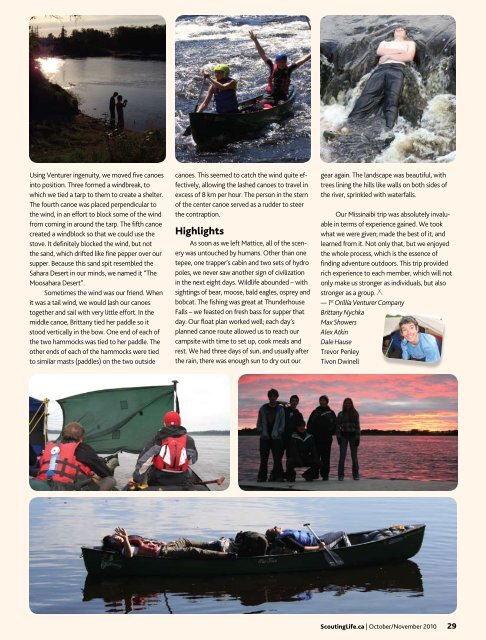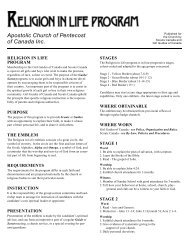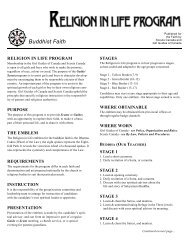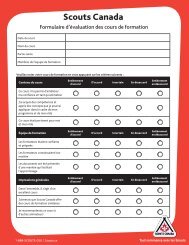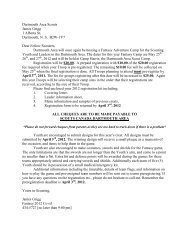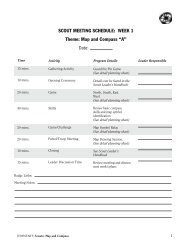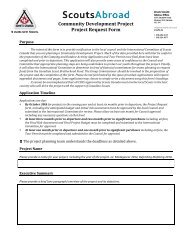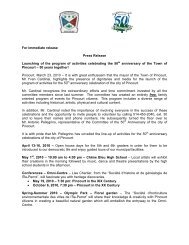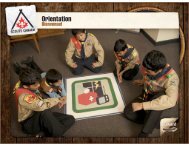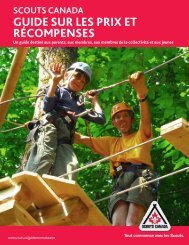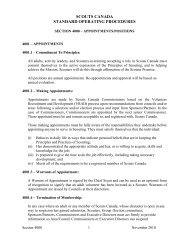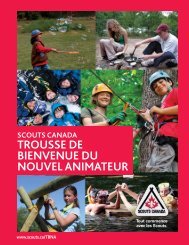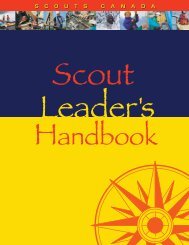Canoeing the Mighty Missinaibi River Canoeing the Mighty ...
Canoeing the Mighty Missinaibi River Canoeing the Mighty ...
Canoeing the Mighty Missinaibi River Canoeing the Mighty ...
You also want an ePaper? Increase the reach of your titles
YUMPU automatically turns print PDFs into web optimized ePapers that Google loves.
Using Venturer ingenuity, we moved five canoes<br />
into position. Three formed a windbreak, to<br />
which we tied a tarp to <strong>the</strong>m to create a shelter.<br />
The fourth canoe was placed perpendicular to<br />
<strong>the</strong> wind, in an effort to block some of <strong>the</strong> wind<br />
from coming in around <strong>the</strong> tarp. The fifth canoe<br />
created a windblock so that we could use <strong>the</strong><br />
stove. It definitely blocked <strong>the</strong> wind, but not<br />
<strong>the</strong> sand, which drifted like fine pepper over our<br />
supper. Because this sand spit resembled <strong>the</strong><br />
Sahara Desert in our minds, we named it “The<br />
Moosahara Desert”.<br />
Sometimes <strong>the</strong> wind was our friend. When<br />
it was a tail wind, we would lash our canoes<br />
toge<strong>the</strong>r and sail with very little effort. In <strong>the</strong><br />
middle canoe, Brittany tied her paddle so it<br />
stood vertically in <strong>the</strong> bow. One end of each of<br />
<strong>the</strong> two hammocks was tied to her paddle. The<br />
o<strong>the</strong>r ends of each of <strong>the</strong> hammocks were tied<br />
to similar masts (paddles) on <strong>the</strong> two outside<br />
canoes. This seemed to catch <strong>the</strong> wind quite effectively,<br />
allowing <strong>the</strong> lashed canoes to travel in<br />
excess of 8 km per hour. The person in <strong>the</strong> stern<br />
of <strong>the</strong> center canoe served as a rudder to steer<br />
<strong>the</strong> contraption.<br />
Highlights<br />
As soon as we left Mattice, all of <strong>the</strong> scenery<br />
was untouched by humans. O<strong>the</strong>r than one<br />
tepee, one trapper’s cabin and two sets of hydro<br />
poles, we never saw ano<strong>the</strong>r sign of civilization<br />
in <strong>the</strong> next eight days. Wildlife abounded – with<br />
sightings of bear, moose, bald eagles, osprey and<br />
bobcat. The fishing was great at Thunderhouse<br />
Falls – we feasted on fresh bass for supper that<br />
day. Our float plan worked well; each day’s<br />
planned canoe route allowed us to reach our<br />
campsite with time to set up, cook meals and<br />
rest. We had three days of sun, and usually after<br />
<strong>the</strong> rain, <strong>the</strong>re was enough sun to dry out our<br />
gear again. The landscape was beautiful, with<br />
trees lining <strong>the</strong> hills like walls on both sides of<br />
<strong>the</strong> river, sprinkled with waterfalls.<br />
Our <strong>Missinaibi</strong> trip was absolutely invaluable<br />
in terms of experience gained. We took<br />
what we were given; made <strong>the</strong> best of it, and<br />
learned from it. Not only that, but we enjoyed<br />
<strong>the</strong> whole process, which is <strong>the</strong> essence of<br />
finding adventure outdoors. This trip provided<br />
rich experience to each member, which will not<br />
only make us stronger as individuals, but also<br />
stronger as a group.m<br />
— 1 st Orillia Venturer Company<br />
Brittany Nychka<br />
Max Showers<br />
Alex Atkin<br />
Dale Hause<br />
Trevor Penley<br />
Tivon Dwinell<br />
ScoutingLife.ca | October/November 2010 29


